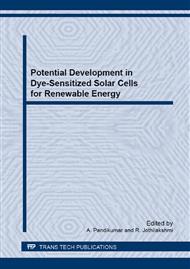p.71
p.91
p.103
p.115
p.121
p.133
p.143
p.159
p.169
Fabrication and Testing of Dye-Sensitized Solar Cell
Abstract:
In Dye-Sensitized Solar Cells (DSSC), the selection of the material used for the fabrication process plays a vital role in determining the performance of the cell. The fabrication and characterization of DSSC with Ruthenizer 620-1H3TBA also known as N749 or black dye as charge transfer sensitizer is discussed in this paper. The black dye exhibits a higher absorbance throughout the entire range of visible spectrum with a peak absorbance at 620 nm and also a good absorbance in ultraviolet region. The cell thus fabricated, with cell area 2.0 cm x 2.1 cm and 487.44 μm thick coating of Titanium dioxide nanoparticles, exhibits an open circuit cell voltage of 0.61 V and short circuit current of 48 μA. Further the morphological characterization of DSSC is carried out and the results were analysed.
Info:
Periodical:
Pages:
121-131
Citation:
Online since:
October 2013
Authors:
Keywords:
Price:
Сopyright:
© 2014 Trans Tech Publications Ltd. All Rights Reserved
Share:
Citation:



